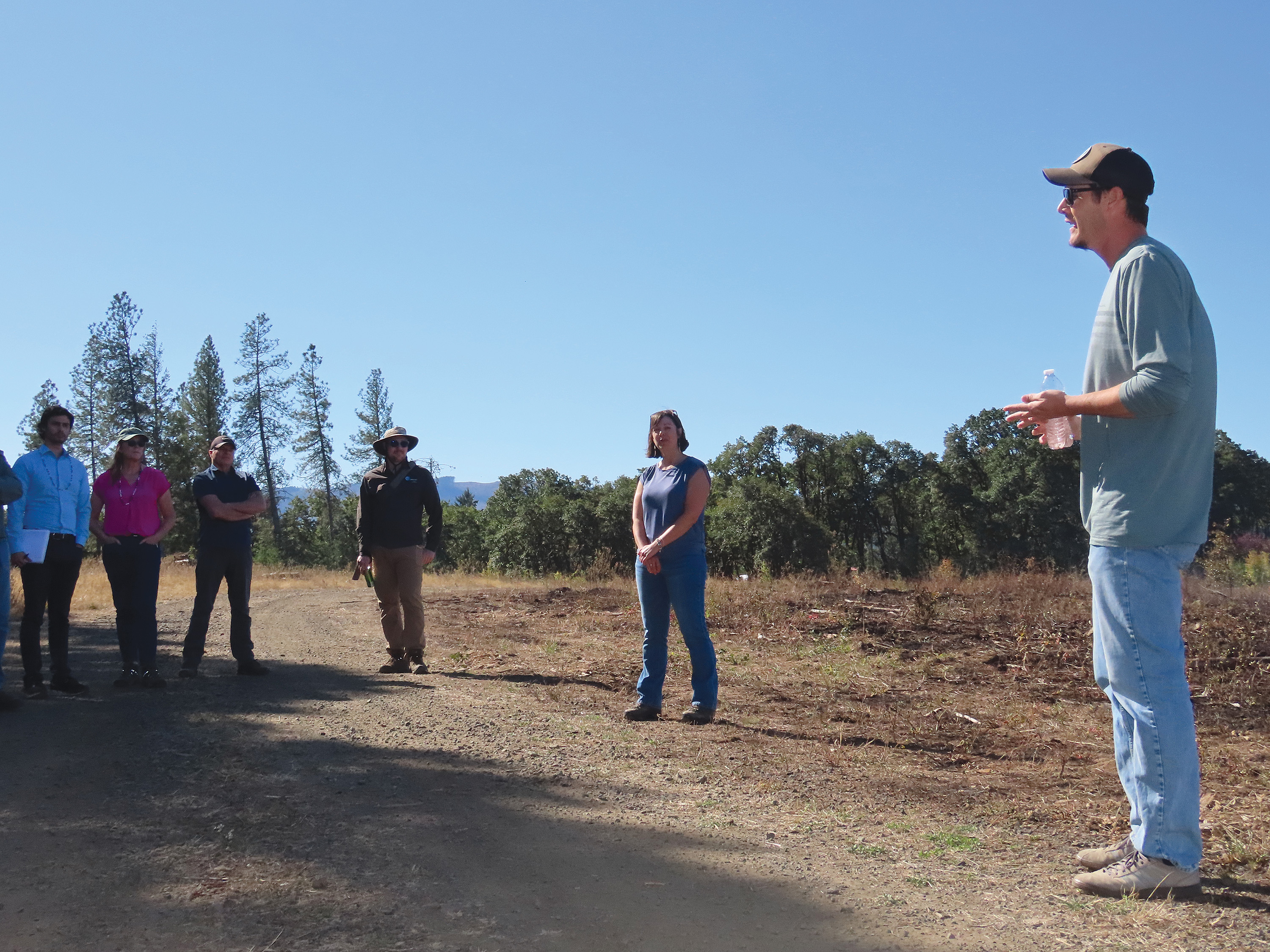Tribal Government & News
Tribe participates in conservation property tour

By Danielle Harrison
Smoke Signals editor
The Confederated Tribes of Grand Ronde, the Oregon Association of Conservation Districts and the Polk Soil and Water Conservation District hosted a tour that included one of the Tribe’s conservation properties, Noble Oaks, a 667-acre site located in Sheridan.
The Thursday, Sept. 25 tour highlighted oak and prairie habitat restoration at the property.
Before the tour began, Tribal Fish & Wildlife Policy Analyst Lindsay McClary gave a brief history of the site, which the Tribe acquired through the Willamette Wildlife Mitigation Program, funded by Bonneville Power Administration and administered by the Oregon Department of Fish and Wildlife. The Tribe owns two parcels at Noble Oaks and parts of the area are in private ownership as well.
“There are two conservation easements on this property because it was acquired in two parcels,” she said. “The Tribe holds the deed to the property but the federal government has oversight through the conservation easements. The good news is that it will always be held as wildlife habitat long after we’re all gone. Hopefully, the wildlife habitat will still be thriving.”
Since time immemorial, the Tribe has been the historical caretaker of the Willamette Valley, which was once home to vast oak and prairie habitats, managed by the Kalapuya using Indigenous fire practices. The Tribe is actively restoring the oak and prairie habitats at Noble Oaks and has successfully returned “good fire” to the site.
Approximately 30 people attended the tour, including several Grand Ronde Tribal government staff, representatives from state Sen. Bruce Starr and Oregon Rep. Andrea Salina’s offices, and employees of various conservation districts, trusts and non-profits throughout the state.
Grand Ronde Tribal Council members in attendance included Toby McClary, Kathleen George and Secretary Jon A. George.
“I’m so grateful that today, we are once again stewards of these lands,” Jon A. George said. “I’m so grateful for our people here today. In partnership with each and every one of you, these lands continue to thrive.”
Lindsay McClary shared that the Noble Oaks site was formerly a wildlife sanctuary but most of the animals were not native to the area. As a result, the giraffes, rhinos, big cats, zebras and impalas did not fare well in the wet Pacific Northwest weather.
The property was eventually acquired by The Nature Conservancy, who worked directly with the Tribe to transfer the property into Tribal ownership in 2019.
In total, the Tribe’s Natural Resources Department manages more than 2,500 acres of conservation land at 12 different sites.
“We’ve been working on doing a lot of different projects,” Tribal Natural Resources Department Manager Colby Drake said. “I’m excited to showcase and share some of this.”
Tribal Fish & Wildlife Program Manager Kelly Dirksen said that McClary had been tasked with a “huge opportunity,” to manage the conservation properties.
“But we gave her no money to do it,” he said. “And she’s done a fantastic job of partnering with people like you or programs like yours to find the funding to do the restoration. I don’t know everyone’s contribution but I feel like you’re going to see some things that some of you helped sign a check to pay for and we’re really proud of that and the work she’s done.”
McClary also recognized Mike Wilson, retired Tribal Natural Resources Department manager and current chair for the Polk Soil and Water Conservation District.
At the first stop on the tour, atop a gravel road with a view overlooking the valley below and with the smell of smoke still in the air, McClary and Drake discussed a recent controlled burn and site restoration.
“We’ve been able to fund our own Tribal employees and Tribal equipment operators to come in and do some stump grinding,” McClary said. “As the burns continue, those will help to break down those existing stumps and the residue…I’d like to highlight that we don’t do this work in a vacuum and we heavily rely on our partnerships, not only for funding but also for collaboration to make those dollars stretch…It takes a village.”
Kathleen George asked Drake if there are ever any issues or concerns from the neighbors or area businesses regarding smoke from the controlled burns. She noted that before a burn takes place, the Tribe sends out an email to all employees and others.
“It’s easy to reach out and do that at the Tribe,” she said. “But what about the folks who are not on our send lists?”
Drake replied that NRD does run into that issue from time to time.
“There are a lot of vineyards in the area and putting smoke up in the air for them is a big concern,” he said. “So, just trying to reach out and check in with our people because there’s a lot of other agriculture and projects going out here that we could impact very easily. So, smoke management is probably one of our biggest things that we’re checking and calling about. When we’re putting up smoke, we get a lot of people interested in what’s going on in the community so it’s really just keeping that communication line open so if we do get the public making fire calls to 911, they can adjust to it and let people know that there’s just good fire going on there.”
The tour was sponsored by the Oregon Conservation Partnership, which includes the Coalition of Oregon Land Trust, Network of Watershed Councils, Oregon Association of Conservation Districts and Oregon Conservation Education and Assistance Network.
After the tour concluded, boxed lunches were served to all participants at the Noble Oaks site.
